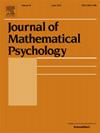了解艾美斯房间的几何特性,并对其进行系统和定量控制
IF 1.5
4区 心理学
Q2 MATHEMATICS, INTERDISCIPLINARY APPLICATIONS
引用次数: 0
摘要
在艾姆斯房间内,当物体(如人)在房间内移动时,感知到的物体(如人)大小会发生动态变化。艾姆斯房间的形状实际上并不是长方形的,但它被认为是长方形的。遗憾的是,艾姆斯房间的几何特性经常被误解,在许多文章中,形状不同的房间也被称为 "艾姆斯房间"。在这项研究中,我们分析了小阿德尔伯特-艾姆斯建造的原始艾姆斯房间的几何特性,并讨论了艾姆斯房间的一般化问题。我们发现,这些原始的艾姆斯房间是矩形虚幻房间的三维到三维透视变换。在这一分析的基础上,我们还开发了一个计算模型,该模型可以构建一个具有六面体形状的广义艾姆斯房间,其一些自由参数可以定量控制:(i) 矩形虚幻房间的大小和长宽比;(ii) 艾姆斯房间与矩形房间的变形量;(iii) 观察者的视角。该模型以计算程序的形式实现,因此可以在虚拟现实空间中构建一个艾姆斯房间。需要注意的是,艾姆斯房间的变换可应用于任意三维场景,它们可被视为三维到三维透视变换子集的成员。该子集中的任何透视变换都会扭曲三维场景,使得从特定视角观看扭曲场景的视网膜图像与从特定视角观看初始场景的视网膜图像完全相同。这些概括使我们在研究这种幻觉时,能够更加灵活地系统控制艾姆斯房间的条件。本文章由计算机程序翻译,如有差异,请以英文原文为准。
Understanding the geometrical properties of an Ames room and controlling it systematically and quantitatively
Within an Ames room, the perceived size of objects, such as people, changes dynamically when the objects move about within the room. The shape of the Ames room is not actually rectangular but it is perceived to be rectangular. Unfortunately, the geometrical properties of the Ames room have often been misunderstood, and rooms that have different shapes are also referred to as “Ames rooms” in many articles. In this study, the geometrical properties of the original Ames rooms constructed by Adelbert Ames, Jr. were analyzed and the generalization of the Ames room was discussed. We found that these original Ames rooms are 3D-to-3D perspective transformations of rectangular illusory rooms. Based on this analysis, we also developed a computational model that can construct a generalized Ames room that has a hexahedral shape with some free parameters that quantitatively control (i) the size and aspect-ratio of a rectangular illusory room, (ii) the amount of distortion of the Ames room from a rectangular room, and (iii) the viewpoint of an observer. This model was implemented as a computational program so that an Ames room can be constructed in a VR space. Note that the transformations of the Ames rooms can be applied to an arbitrary 3D scene and that they can be regarded as members of a subset of 3D-to-3D perspective transformations. Any perspective transformation in this subset distorts the 3D scene in such a way that the retinal image of the distorted scene, when seen from a specific viewpoint, is identical to the retinal image of the initial scene, when seen from a specific viewpoint. These generalizations allow us to control the conditions of an Ames room systematically with more flexibility when we study this illusion.
求助全文
通过发布文献求助,成功后即可免费获取论文全文。
去求助
来源期刊

Journal of Mathematical Psychology
医学-数学跨学科应用
CiteScore
3.70
自引率
11.10%
发文量
37
审稿时长
20.2 weeks
期刊介绍:
The Journal of Mathematical Psychology includes articles, monographs and reviews, notes and commentaries, and book reviews in all areas of mathematical psychology. Empirical and theoretical contributions are equally welcome.
Areas of special interest include, but are not limited to, fundamental measurement and psychological process models, such as those based upon neural network or information processing concepts. A partial listing of substantive areas covered include sensation and perception, psychophysics, learning and memory, problem solving, judgment and decision-making, and motivation.
The Journal of Mathematical Psychology is affiliated with the Society for Mathematical Psychology.
Research Areas include:
• Models for sensation and perception, learning, memory and thinking
• Fundamental measurement and scaling
• Decision making
• Neural modeling and networks
• Psychophysics and signal detection
• Neuropsychological theories
• Psycholinguistics
• Motivational dynamics
• Animal behavior
• Psychometric theory
 求助内容:
求助内容: 应助结果提醒方式:
应助结果提醒方式:


